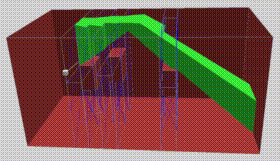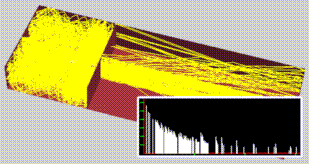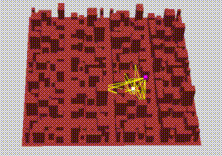 |
|
|
|
|
|
|
|
|
|
|
|
|
|
|
|
|
|
|
|
|
|
|
|
|
|
|
|
|
| http://www.oocities.org/SiliconValley/Port/9258/CompGraphics.html |
|
|
|
RESEARCH PAPER |
|
|
|
ACM SIGGRAPH PROCEEDINGS |
|
|
| |
|
|
| Title: Interactive Acoustic Modeling of Complex Environments |
|
|
| Authors: Thomas A. Funkhouser, Ingrid Carlborn, Gary Elko, Gopal Pringali, Mohan Sondhi, Jim West |
|
|
| Presented by: Ng Kae Mun, Bernard |
|
|
| Purpose of Paper: To develop data structures and algorithms to enable interactive simulation of acoustic effects in large 3D environment. |
|
| Major Contribution: "Beam tree" – maps the convex pyramidal beam-shaped paths of significant transmission and specular reflection from a point source through 3D space. |
|
| Method used: pre-compile and store a spatial data structure that can be used during an interactive session for evaluation of reverberation paths. |
|
| Results and Discussion: |
|
|
| 1) Beam tree is generated by: |
|
|
| a) Partitioning 3D space into convex polyhedral regions |
|
|
| b) Computing the convex polygonal boundaries between regions |
|
|
| c) Recursively splitting and tracing convex polyhedral beams from a source point through region boundaries (eg. Reflecting beams at opaque boundaries) |
|
| 2) The pre-computed beam tree data structure can be used to compute specular reflection and transmission paths from a source position to any point in space at interactive rates. |
|
| 3) The lengths and directions of computed reveration paths may be used to spatialize audio source signals to a receiver moving under interaction control by a user. |
|
| 4) These data structures and algorithms have been integrated into a system for interactive acoustic modeling. The system takes as input: |
|
| a) a set of polygins describing the geometry and acoustic surface properties of the environment, and |
|
|
| b) a set of anchoic audio source signals at fixed locations. |
|
|
| 5) It outputs an audio signal auralised according to computed delays, directions and attenuations of the specular reverberation paths from each source to receiver point. |
|
| 6) The receiver point can be moved interactively by the user allowing real-time exploration of acoustic environments. |
|
| SUMMARY: |
|
|
| 1) Computer-aided acoustic modeling tools are important for design and simulation of 3D environments. |
|
|
| 2) It is also used to provide sound cues to aid understanding, navigation and communication in interactive virtual environment applications, especially updating acoustical simulations at interactive rates. |
|
| 3) Its primary challenge is computation of reverbation paths from a sound’s source position to a listener’s receiving position. |
|
| 4) As sound may travel from source to receiver via a multitude of reflection, transmission, and diffraction paths, accurate simulation is extremely compute-intensive. |
|
| 5) Its current approaches include: |
|
|
| a) Image source methods – |
|
|
| Complexity grows with O(n^r) whereby n = surfaces and r = reflections. |
|
|
| b) Ray-tracing methods – |
|
|
| Prone to sampling error and lots of computation to trace many rays. |
|
|
| 6) The solution is using a "beam tree" data structure which is later used during an interactive session for reverberation paths like specular reflection and transmission paths that are used to spatialize audio source signals to a receiver. |
|
| 7) Together with algorithms, a system for interactive acoustic modeling is created! |
|
|
 |
|
|
 |
|
|
 |
|
|
| Webpage: http://www.cs.princeton.edu/~funk/rsas.html |
|
|
| |
|





